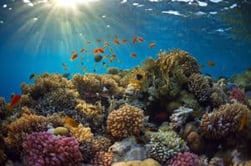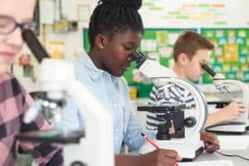Ecosystems Station Labs for Student-Centered Learning
I have created a series of station labs to teach some common concepts relating to ecosystems, ecology, and how organisms interact with each other. Each of the labs is student-centered and differentiated based on learning styles.
All of the labs listed below have 8 stations (4 input, 4 output). Students will be exploring, researching, watching, reading, writing, illustrating, organizing, and assessing. You can read more about how to setup effective station labs here.
In this blog post I'm going to highlight one or two of the stations for each of the different labs. The topics covered in the ecosystems labs are: Classification (taxonomy), Abiotic and Biotic Factors, Biodiversity, Biomes, Natural Selection, Organism Relationships (predator/prey, parasite/host, consumer/producer/decomposer), Energy Pyramids, Food Chains and Food Webs, Short and Long-Term Environmental Impacts, and Catastrophic Events.
Classification of Living Things
The write it station allows students to reflect from the lab and write out answers to three different questions. They will have to explain why scientists use the classification system, explain the how prokaryotes are classified differently from eukaryotes, and be able to describe the 3 main domains used to classify living things.

Biotic and Abiotic Factors in an Ecosystem
In the explore it station the students will be asked to organize the cards into two piles before using their own method of categorization. They will then be introduced to the terms biotic and abiotic factors and be asked to re-order the cards into new piles based on whether or not the card is a biotic or abiotic factor.
At this organize it station students will have to rely on information learned in the station lab to determine whether or not the activity on the card is either a biotic or abiotic factor.
Biodiversity
During the biodiversity lab students will be exploring organism populations and how an increase in the number of species increases the biodiversity in the ecosystem. They will also be asked to make predictions to organism populations if organisms are removed or added to the ecosystem.
Biomes
At the organize station in the biomes lab the students will be using a detailed map of the worlds biomes to answer a series of questions about biodiversity and the different biomes.
At the illustrate is station students will use a map of the main biomes on Earth to color code their lab sheets accordingly. Students are required to create a legend, but the biomes map is already included on the student lab sheet. This station allows students to get familiar with each of the main biomes and start to make connections how they fit together as a whole.
The explore it station of the biomes lab will introduce students to the concept of a biome and allow them to explore the different biomes and characteristics of each. There is also a series of questions about microhabitats. Students will learn the term microhabitats and provide some of their own examples using the definition provided.
Natural Selection
The explore it station in this lab will teach students about natural selection using the classic example of the peppered moths. Students will get an overview of the peppered moth scenario and get to place light and dark colored moths on the trees. This is one of my favorite stations, because natural selection is crystal clear after they have visited the station.
At the read it station students will learn the difference between natural selection and artificial selection. They will be asked 4 questions about the article including comparing and contrasting natural selection and artificial selection, as well as problems that can occur with selective breeding.
Organism Relationships Within an Ecosystem
Students will explore predator-prey, parasite-host, and producer-consumer-decomposer relationships at the explore it station. They will use a common forest food web to try and name the different relationships which exist after learning the new vocabulary. They are then challenged to think of new relationships which may exist in another ecosystem.
Energy Pyramids
While students are watching a 5-minute video about energy pyramids they will be answering a series of questions about the flow of energy in an ecosystem. They will learn that producers are the most abundant organisims and energy is lost as it transfers through the ecosystem. They will also learn the terms producers, decomposers, and consumers.
Food Chains and Food Webs
Students will learn about food chains and food webs at the explore it station in this lab. They will be asked to think about the different organisms which live in a desert ecosystem and then determine the relationships that exists amongst them. Afterwards, they will use a completed food web to answer some questions. Finally, the student will create their own mini food web using their own organisms. This station will also teach them about how the arrows represent the flow of energy through the ecosystem.
Short-Term and Long-Term Environmental Impacts
Students will investigate different impacts to the environment and decide how they impact the ecosystem. They will also learn if the results of these impacts are short or long-term. Some of the impacts are natural events while others are created by humans. This activity can spark a lot of great discussions about the impacts on our environment.
Catastrophic Events
The explore station in the catastrophic events station lab will have the students look at 6 images and try to match up the characteristics and impacts that each of these events can have on the environment.
Ecosystems Station Labs
Each of the station labs can be purchased individually by clicking on the images or you can buy the bundle which includes all 10 labs for a steep discount.
Download Over $100 in FREE Resources
For Middle School Science
Simply create a login below and gain immediate access to a selection of our Kesler Science product line worth $100 - for FREE. There's a full version of every product type! You'll also join tens of thousands of middle school science teachers who receive timely tips and strategies straight to their inbox.






